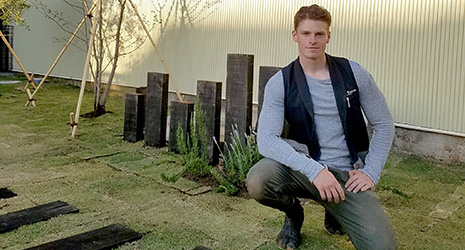Home > Highlighting JAPAN > Highlighting Japan August 2017 > My Way
Highlighting JAPAN


The Garden Path
Garden designer Jakob Sebastian Björk, better known as Tatsumasa Murasame, works to preserve Japan’s deep gardening culture.
Jakob Sebastian Björk, originally from Sweden, lives with a Japanese tortoiseshell cat surrounded by antiques in a city in the Kanto area that retains the old charm of Japan beloved by distinguished men of letters. Björk, who has acquired Japanese citizenship, has taken the Japanese name “Tatsumasa Murasame.”
“The family name ‘Murasame’ was given to me by my master. The given name ‘Tatsumasa’ is a combination of ‘dragon’ (tatsu), the [zodiac] year when I was born, and one character from my master’s name,” says Murasame.
The person that Murasame refers to as “master” is the president of a landscape gardening company in the Chubu region, where Murasame studied for five years as an apprentice. Murasame has worked as a designer of Japanese gardens for seven years now. “Western gardens are created in a symmetrical shape with neat lines and you can easily see that they are beautiful. But Japanese gardens based on Buddhist philosophy adopt natural elements that are not standardized. The older they become, the more mature they grow. The more I learn about the beauty of Japanese gardens, the more I understand the depth of their beauty,” says Murasame.
Murasame, who was raised in a small town in the southernmost part of Sweden, dreamt about foreign cultures since he was a child and was captivated by researching the history and culture of countries all over the world. The one that he paid particular attention to was Japan, an island nation with a unique culture cultivated over many years. As a high school student, he was invited to Japan by a Japanese friend with whom he enjoyed writing on the Internet and he experienced a three-month homestay in Yokohama. This experience influenced his decision to live in Japan. He returned to Sweden, and visited Japan again after graduating from high school. When finally he moved to Japan, it was a dream come true.
In the beginning, Murasame worked at jobs that required linguistic skills, such as English and Swedish teacher, interpreter and translator, to make a living. On holidays, he enjoyed visiting castles dating from the Warring States period (1467–1568), which he loved very much. One day he visited Adachi Museum of Art in Shimane and was greatly impressed by its magnificent Japanese garden. He had thought that Japanese culture would be distant from Swedish culture, but he discovered that the aesthetic sense of regarding nature as something special within Japanese gardens could also be seen in the Swedish view of nature. So when he came across a recruitment advertisement for a landscape garden designer, he applied for the position without hesitation. His application was accepted.
Initially Murasame did only apprentice work such as cleaning, but studied hard while watching the master and senior apprentices at work. The master recognized his passion and taught Murasame many things, such as how to use the tools and the nature of trees. Murasame eventually became a garden designer skilled enough to be entrusted with the work of pruning a pine tree, which is the test of a full-fledged garden designer.
Murasame has since moved on to another company and is currently engaged in designing and constructing gardens in response to client requests. His dream is to build a Japanese garden from scratch on his own. However, there are not so many orders for the construction of Japanese gardens and, worse, Murasame has had to field requests to demolish old gardens.
“I understand that it is difficult for individual households to continue to maintain and manage large Japanese gardens. But I hope to persuade people to keep the precious trees and attractive stones, even if they reduce the size of their gardens. Once the elements that had obtained harmony for many years are removed, they will never return to their old state,” Murasame says solemnly.
For a time Murasame had wanted to disseminate the positive aspects of Japanese gardens to other countries, but has come to realize that he needs to communicate the beauty of Japanese gardens to Japanese people as well.
“Traditional culture is a significant asset of Japan, because many foreigners come to Japan to enjoy it. Not only should Japan preserve traditional culture with great care and attention, it should also strengthen such efforts,” says Murasame.
“Bonsai is now more popular abroad than it is in Japan,” he points out. “I will seek what I can do as a Japanese citizen and garden designer so that more Japanese people will reflect on and embrace the positive aspects of Japanese culture such as can be found in a mature Japanese garden.”
© 2009 Cabinet Office, Government of Japan







